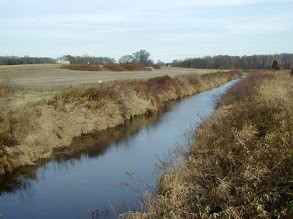Runoff from agricultural areas caused high bacteria levels in Delaware’s Tappahanna Ditch of the Choptank River. As a result, the Delaware Department of Natural Resources and Environmental Control (DNREC) added the watershed to the 1996 Clean Water Act (CWA) section 303(d) list of impaired waters for bacteria and nutrients. Watershed stakeholders provided technical assistance and installed agricultural best management practices (BMPs) in the watershed, causing bacteria levels to improve. As a result, DNREC removed Tappahanna Ditch from the state’s 1996 list of impaired waters for bacteria in 2018.
Tappahanna Ditch is located in the Choptank River watershed on the western edge of Delaware in Kent County. The Choptank River watershed consists of the Tappahanna Ditch in the northern portion of the watershed, Culbreth Marsh Ditch in the center, and Cow Marsh Creek in the lower portion. The drainage area of the Choptank River watershed spans approximately 97 square miles.

Primary sources of nonpoint source pollution in the watershed include runoff from agricultural activities such as fertilizer and manure application and concentrated areas of animal production.
Monitoring data collected in the late 1990s demonstrated that Tappahanna Ditch’s failed to meet the state’s enterococcus bacteria numeric criterion, which requires that the annual geometric mean be less than 100 colony-forming units (CFU) per 100 milliliters (mL). In addition, Tappahanna Ditch did not support its freshwater primary contact designated use, causing the state to add the watershed to Delaware’s CWA section 303(d) list of impaired waters for bacteria.
In 2006 the U.S. Environmental Protection Agency developed a total maximum daily load (TMDL) to address the nutrients and bacteria loading throughout the Chesapeake Bay watershed, which includes Tappahanna Ditch. Nutrient TMDLs for the Choptank River include a yearly-average cap on total nitrogen at 1,359 pounds per day and a 40% reduction in phosphorus levels. In addition, the NPS bacteria load in the Choptank River requires a 29% reduction.
The Kent Conservation District (KCD) offered technical assistance to the farming community by providing nutrient management planning and cost-share funding for agricultural BMPs. KCD also partnered with the U.S. Department of Agriculture’s (USDA’s) Natural Resources Conservation Service (NRCS) to develop conservation plans and Environmental Quality Incentive Program (EQIP) contracts. Watershed partners worked with landowners to enroll 4,500 acres of cover crops over five years and implement nutrient management plans on approximately 3,000 acres.
In addition, several agricultural BMPs were installed on poultry operations within the watershed, including 17 manure storage structures, 11 poultry carcass composters, 30 heavy use area protection pads, 1 animal waste liquid handling system, and the transfer of 115 tons of manure. The KCD planners continue to work with farmers throughout the watershed, providing ongoing technical assistance to ensure improved water quality.
Delaware’s USDA Conservation Reserve Enhancement Program (CREP) was established in 1999 to protect and enhance environmentally sensitive land and waters in the coastal plain geographic areas of the Delaware, Chesapeake and Inland Bays watersheds by establishing voluntary land retirement agreements with agricultural producers. To assist in CREP program development and implementation, in 1999, Delaware’s Nonpoint Source Program committed CWA section 319 funds to create a full-time Delaware CREP Program Coordinator position. The CREP Program Coordinator facilitated the installation of 62 acres of grass buffers, 1 acre of riparian buffers, 25 acres of wildlife plantings, and 54 acres of hardwood trees in the Tappahanna Ditch watershed.
Bacteria levels have decreased in response to the more than 10 years of water quality protection and restoration efforts in the Tappahanna Ditch-Choptank watershed. The DNREC collected monitoring data at STORET Station 207081 in Tappahanna Ditch between January 2012 and December 2016. The geometric mean of the 45 samples collected over the 5-year period was 72 cfu/100 mL. This was well below Delaware’s fresh water bacteria water quality standard, 100 cfu/100 mL. As a result of the improved improved bacteria water quality standard, the DNREC removed the 7.5 mile segment of Tappahanna Ditch (DE-110-001) from the State’s list of impaired waters in 2018 according to its Assessment and Listing Methodology. The 2018 Integrated Report shows the segment continues to meet the applicable water quality standards for bacteria due to continued restoration efforts in the watershed.
Key partners include KCD, NRCS, and the Delaware Nonpoint Source Program. Approximately $1.1 million in federal NPS 319 funds supported the costs of the Tappahanna Ditch restoration effort. Additional funding came from the USDA (through EQIP and CREP) and Delaware’s Conservation Cost Share Program (which was provided through DNREC to KCD). This project demonstrates the success of program and funding coordination among the state conservation district, NPS 319 funding, the Conservation Reserve Enhancement Program, Delaware Conservation Cost Share Program and engaged landowners.
Related Topics: conservation, nonpoint source, story, success, Tappahanna Ditch, water quality, watershed